August 11, 2008
Putting together a complete "budget" HD field kit for under $20,000.00
When Cirina Catania, the
producer of Larry Jordan's Digital
Production BuZZ, asked me to put together a "budget"
field kit for a segment on the show, my first question is "who's
budget"! For some people a $5,000 kit would be a big expenditure
while others spend $50-80,000 on a complete field camera, mounts,
grip, etc kit. We decided that $20K would be the target, but
it would be nice if we could have a field "deck" (or
modern solid state equivalent) for media management and playback
in the field independent of the camera.
Camera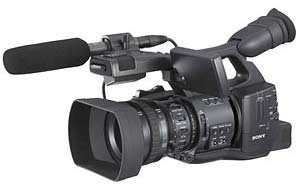
From my research for the HD Survival
Handbook I think Sony's
XDCAM EX-1 is currently the best bang-for-buck camera out
there. The main reason to shy away from it is the form factor:
that prosumer shape doesn't shoulder mount without accessories,
so if thats a primary consideration, then consider the Sony
HVR 270U or JVC
GY-HD200 or HD250.
The main reasons for the EX-1 are that it uses full raster 1920 x 1080 1/2" CMOS sensor. Almost all affordable cameras "cheat" by using lower resolution sensors and pixel shift to interpolate (create) resolution. No cheating with the EX-1. The full raster is retained in the 35Mbit/sec VBR format that most people use with this camera. It also has an HDV-compatible 25Mit/sec format at 1440 x 1080). I also like the 1/2" sensor over the 1/3" sensors because it has better sensitivity in low light. Not surprising that bigger sensors get more light falling on them.
The EX-1 can do both 1080 and 720 format at all common frame rates, including a 24p mode at both 1080 and 720. (This is with 2:3 pulldown unfortunately, because that needs to be converted to ProRes 422 on capture for pulldown removal in Cinema Tools.) It also does variable frame rate from 1 - 60 fps in 720P mode and 1-30 fps in 1080P mode.
Although theoretically susceptible to the "rolling shutter" syndrome, none of the dozen or show shooters I know that have, and love, this camera have found it to be an issue for them.
If you have a higher budget and want genlock or removable lens capability, the newly released EX-3 might suit your needs better. The EX-1 goes in our budget at $6500, with another $2500 for batteries, cables, charger and SxS cards.
Camera and accessories
$9,000
Something to stand on
Easily overlooked but very important, is a good tripod. This
is one place where spending a few more dollars will really pay
off. You need sticks that are solid, do no bend and are easily
collapsed and expanded. A good tripod has a ball leveler, for
quick leveling of the camera mount without futzing with changing
leg lengths on uneven ground and a fluid head.
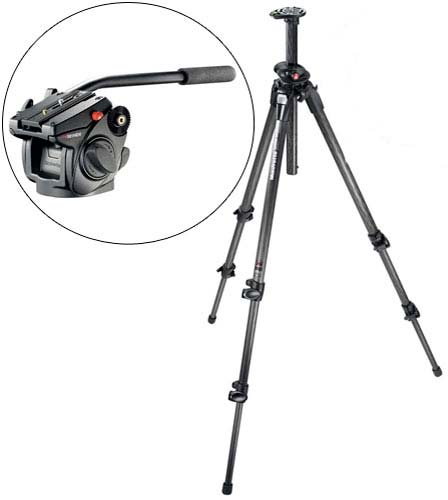 Start
with the Bogen/Manfrotto
501HDV fluid head and add the sticks of choice to go with
it. The fluid head will cost around $180 and with a carbon fiber
tripod (lightweight and very strong) about $475. If you want
a center lift it'll add $110.)
Start
with the Bogen/Manfrotto
501HDV fluid head and add the sticks of choice to go with
it. The fluid head will cost around $180 and with a carbon fiber
tripod (lightweight and very strong) about $475. If you want
a center lift it'll add $110.)
If you have a little more to spend (and
it'll be worth it) Larry Jordan likes the Sachtler
SOOM 4160 Tripod System. Very versatile, including a monopod
configuration and a rising center lift for additional height
beyond the tripod, it's a great kit but it comes in at $1650.
Reviewed at DV.com.
You will need a monopod for run-'n-gun shooting without the shake
and weave that betrays the amateur. Bogen/Manfrotto have the
budget 6760 at $80, but there are better options with foot stabilizers
or a mini-tripod at the base of the monopod like the Manfrotto
682B Self Standing Monopod.
Going with the basics
our support kit will set us back $555.
If video is painting
with light, we need some
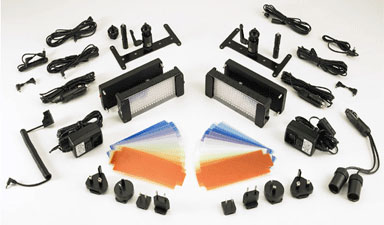 There's now ay a field kit will be complete without
lighting. Traditionally I'd be recommending Blondes and Redheads,
which I still do if you're dating, but for lighting I much prefer
the robust and eco-friendly (not to mention cool) LED fittings.
There's now ay a field kit will be complete without
lighting. Traditionally I'd be recommending Blondes and Redheads,
which I still do if you're dating, but for lighting I much prefer
the robust and eco-friendly (not to mention cool) LED fittings.
My ideal kit would be a LitePanel
1x1, Two Lightpanel
mini's and Lightpanel
Micro for a camera light. That kit will come to $3880 and
is highly recommended. If you look inside the back pages of the
trade magazines you'll find less expensive competitive offerings.
Once upon a time I bought purely on price, but as I matured in
business I've moved to buying on value. You could also consider
the Rosco
DL series but the light is softer and won't give the levels
that the LitePanel kit will give and they have no built-in dimmer.
One of the nice things about LED is that they can be dimmed without
changing color temperature. If you're still looking for alternatives
check out Zylight.
We'll also need C-stands and various clamps, sandbags and cables.
Set aside at lest $300 to get you started, but expect to add
to it as needs arise.
LED Lighting Kit
$4100
Can you hear me now?
People forgive bad vision
but they don't forgive poor audio. An absolute minimal audio
kit will include a shotgun microphone, boom pole and a lapel
radio mic kit. You'll soon grow beyond that but this will get
you started.
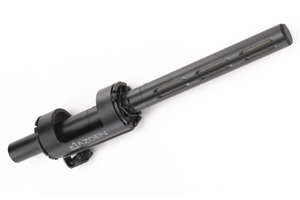 Boom
microphones can be expensive and, in general, you pay for what
you get. The top-end Sennheiser
shotgun will run you around $2500 - way over the top for a budget
kit. Instead I settled on an Azden
SGM-1X - Super-Cardioid Shotgun Condenser Microphone at $150.
It's a good compromise that can be used on camera for directional
atmosphere (not for talent sound) or on a pole for talent audio.
You'll need a windshield and the K-ZFC
Slip-On Fleecy Windscreen (Long) from K-Tek will do the job
for around $80.
Boom
microphones can be expensive and, in general, you pay for what
you get. The top-end Sennheiser
shotgun will run you around $2500 - way over the top for a budget
kit. Instead I settled on an Azden
SGM-1X - Super-Cardioid Shotgun Condenser Microphone at $150.
It's a good compromise that can be used on camera for directional
atmosphere (not for talent sound) or on a pole for talent audio.
You'll need a windshield and the K-ZFC
Slip-On Fleecy Windscreen (Long) from K-Tek will do the job
for around $80.
That boom pole you'll be needing, along with some strong arms
to hold it for any length of time, also comes from K-Tek.
If there was the budget there I'd go for one of theirs.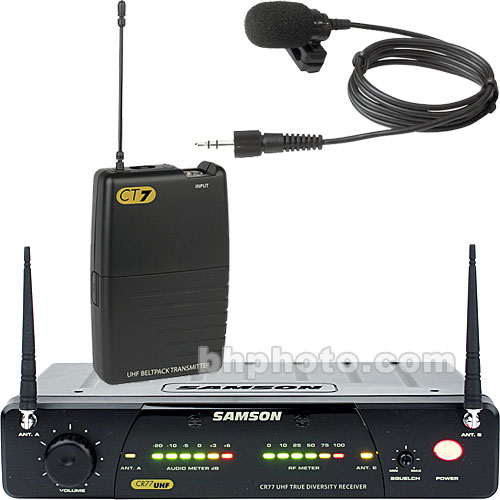
If I had the budget I'd go for the K-Tek
KA-113CCR 6-Section Articulated Boom Pole with XLR Coiled
Cable (Side Exit) and 5 Locking Positions - Measuring 1.4 to
9.5' for around $800, but instead we'll go for the K-Tek
KEG-88 Traveler Carbon Fiber Boom Pole at $370. (Yes, I know
that's more than the microphone, but the pole will continue to
do duty long after you upgrade the microphone.)
Like shotguns, radio microphones come in a wide range of prices.
Highly desirable is a diversity
receiver. In a diversity receiver there are two independent
receivers, with their own aerials, and the receiver chooses whichever
output has the best signal, moment by moment. I'm going for a
Samson
Concert 77 - Wireless Lavalier Microphone System with CR77
Receiver, CT7 Body-Pack Transmitter with Samson LM5 Lavalier
Microphone at $220, which is the lowest price diversity system
at B&H photo.
You'll also need (or someone will) noise isolating headphones
for location monitoring. Figure at least $50 and up. Figure $100
for cables and audio adapters for getting direct feeds from mixers
and PA systems.
Our Audio kit
is going to add $890 to our budget
Tommy can you see me,
Tommy can you hear me?
Field monitor of vision,
audio and the signals is important. (Ya think?) You need know
that the image looks like it should, the audio sounds like it
should and all technical parameters are within acceptable limits.
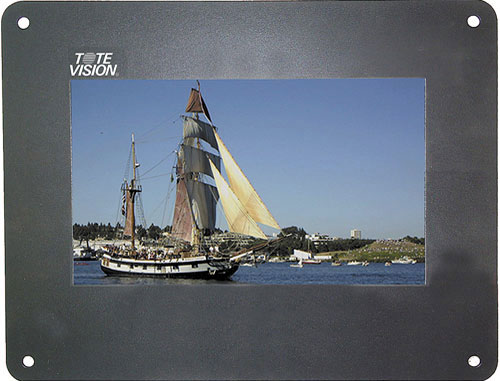 The
least expensive LCD field monitor I could locate that will take
an HD signal was a Tote
Vision LCD-703HDLX 7" Flush-Mounted LCD Field Monitor,
includes Underscan, BlueGun, 16:9, NTSC/PAL Auto-Switch, 1080p/i,
720p. While this accepts an 1080 or 720 HD signal, the display
is not HD. Good enough to approximate color and framing but no
additional value for focus assist, but at $650 it'll do the job
for a budget kit.
The
least expensive LCD field monitor I could locate that will take
an HD signal was a Tote
Vision LCD-703HDLX 7" Flush-Mounted LCD Field Monitor,
includes Underscan, BlueGun, 16:9, NTSC/PAL Auto-Switch, 1080p/i,
720p. While this accepts an 1080 or 720 HD signal, the display
is not HD. Good enough to approximate color and framing but no
additional value for focus assist, but at $650 it'll do the job
for a budget kit.
You'll need a Hoodman hood
to see the screen in daylight, so expect to spend another $90
on that.
For signal monitoring your choice will depend if you're on Mac
or PC. If you have a Mac laptop around, I'd install VeeScope
LIve to provide a real-time Waveform Monitor and Vectorscope
Live for $100 with the bonus that you can do a real time chroma
key and record to disk with the same software. Adobe's On Location,
included with the Production Premium will do the same job.
Excluding the
Mac or PC Laptop, monitoring will cost a minimum of = $840.
And the winner is...
Adding all our minimums together,
I've managed to spend $15,385
of my $20,000 budget. In practice,
I'd add at least $500 into my budget for sundries, which are
inevitable, and take the total to $15,885. Also note that all
prices are without sales tax. If you're liable then you'll need
to set aside approximately $1350, although in some states production
purchases are tax exempt if you do the right paperwork.
You could certainly go with less expensive lighting options,
and spend the difference on a better tripod, shotgun mic and
better monitor, or you could provide some sort of location playback
deck or solid-state media offload.
There are lots of options that you might choose from. With the
EX-1 as your camera, the XDCAM
PMW-EX-30 Recording deck for $4200 will add a lot more versatility
to your system and be useful in post production as well.
If you were to choose the upcoming HPX-170
from Panasonic as your camera of choice (almost as good as the
EX-1) then the AJ-PCS60G
P2 Store will be useful for offloading of cards. Remember
that a laptop, with appropriate slot adapters, can also be used
to offload P2 or SxS media cards.
Those that opt for HDV as the acquisition format, perhaps with
the Sony HVR 270U or JVC KY-HD200 or HD250 (for the form factor)
then an HDV field deck would be desirable. Choices are Sony's
HVR-M15 at around $2500 or JVC's
BR-HD50U at $2850. I'd go with the one that matched the camera
family: JVC deck with JVC camera, Sony with Sony.
These certainly aren't the only choices, but I think they're
good choices for a $20,000 budget, that also allow sufficient
flexibility to "make it your own".
copyright©intelligent assistance 2008
Philip Hodgetts
is a noted speaker, writer, commentator, journalist and broadcaster.
He is the author of The
HD Survival Handbook (a complete reference to all things
HD) and co-developer of The
Assistant Editor. He is President of Intelligent
Assistance and Open
TV Network, the easiest way to sell shows online.
[Top]
© 2000 -2008 Ken Stone. All rights reserved. Apple, the Apple logo, Final
Cut Pro, Macintosh and Power Mac
are either registered trademarks or trademarks of Apple. Other
company and product names may be trademarks of their respective
owners.
All screen captures, images, and textual references are the property and trademark of their creators/owners/publishers.